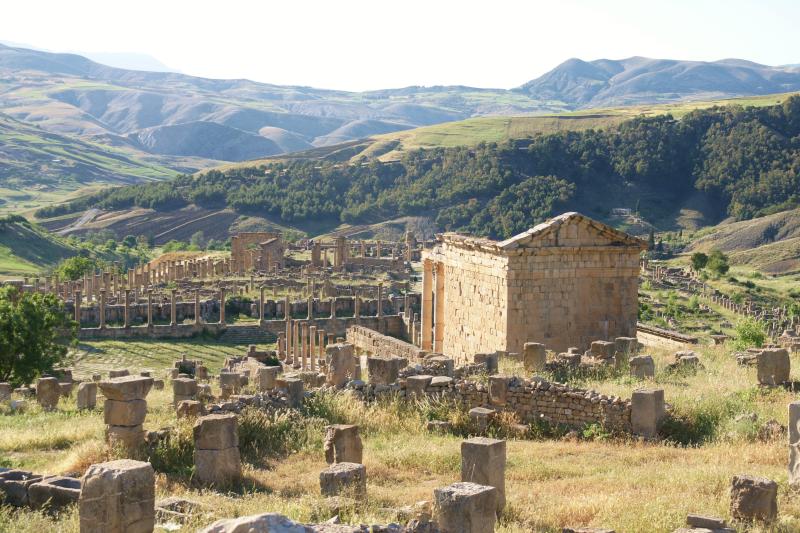In 2009, a team excavating at Algiers’ Place des Martyrs in advance of the construction of a new Metro station uncovered a huge archaeological site beneath the square. This unexpected discovery revealed evidence of many centuries of occupation – from Roman ruins and mosaics through to a 7th-century Byzantine necropolis and the remains of an Ottoman-era mosque, all at the heart of the city.
Since then, the Algerian authorities have changed their designs for the Metro station – making it much smaller, and adding an open-air museum, where visitors will be able to view the site’s remains in situ, as well as a museum building for objects that need to be moved inside. Recently, it was announced that this museum-station would be inaugurated in November, bringing the world’s attention to the archaeological discoveries beneath Place des Martyrs and to the country’s often ignored archaeological treasures as a whole.
Ruins at an archaeological site on Algiers’ Martyrs Square (2 March, 2017). Photo: STRINGER/AFP/Getty Images

Plagued by civil war and instability during the last decade of the 20th century, and under an official ‘state of emergency’ until 2011, Algeria never achieved the tourism numbers enjoyed by other North African countries, such as Egypt, Tunisia, and Morocco, over the same period. Today still, travel advisories remain in place from a number of governments, including the UK, who warn of a risk of terrorism and kidnapping. As a result, Algeria’s treasure trove of archaeological sites remain little known outside the country, beyond specialists and travellers willing to take the risk.
When the security situation does improve, however, and tourists start to visit Algeria in greater numbers, they will find a country filled with historic sites from across its long history, many in a remarkable state of preservation. Indeed, a potted history of Algeria can be told through its seven Unesco world heritage sites alone.
Tassili n’Ajjer in south-east Algeria. Photo: magharebia/Wikimedia Commons (used under Creative Commons licence [CC. BY 2.0])

The earliest of Algeria’s world heritage sites is Tassili n’Ajjer in the country’s south east. Known for its scenic beauty as much as for its cultural importance, the site is home to 15,000 examples of rock art created from around 10,000 BC onwards – a time when the Sahara was transforming from a lush savannah into the desert of today. These artworks display people and animals – some, such as giraffes, now absent from the region – and reflect the religious practices and daily life of Algeria’s earliest recorded inhabitants. They are among the most important examples of Neolithic rock art known.
Much later, over the course of the first millennium BC, the Phoenicians established port cities in Algeria, with their descendants in the region coming to be known as Carthaginians or Punics. The earliest archaeological remains at Tipasa, about 60km west of Algiers, represent this phase of history. The town was founded as a trading centre in the 6th century BC, and has one of the largest Punic cemeteries known, though much of the site’s remains date to later times, including the Roman baths and amphitheatre, and two churches from the Byzantine period.
The Romans arrived in Algeria in AD 24, and of the sites from this era, Timgad (ancient Thamugadi) is among the best preserved. Built under Emperor Trajan as a military outpost, its grid plan street layout can still be seen, complete with ruts cut into the ground by chariot wheels. Along its streets were baths and houses, a public library, a theatre, and Trajan’s Arch. Such was Timgad’s importance that it remained in use from AD 100 to the 8th century. The Roman site of Djémila, built on the side of a mountain in northern Algeria during the late 1st century AD, is also a well preserved ancient town with a long period of occupation. Christianity was adopted across the Roman empire a couple of centuries after Djémila’s founding, and Roman temples gave way to Christian basilicas, which can still be seen there today.
Djémila was founded in the 1st century AD as a Roman settlement on the side of a mountain. Photo: Yves Jalabert/Wikimedia Commons (used under Creative Commons licence [CC. BY 2.0])

In the 7th century, Algeria became part of the Islamic world, and in the 10th century followers of an Islamic movement called Ibadism settled in the M’Zab Valley, where they built five fortified villages (ksour). They are still in use today. Inscribed on the Unesco world heritage list in 1982, these villages retain their traditional architecture and layout: each has a mosque at its centre, its minaret doubling as a watchtower, surrounded by concentric rings of housing. Dating from roughly the same period, Al Qal’a of Beni Hammad, another Algerian world heritage site, was once the fortified capital of the Hammadid dynasty (1008–1152). Built in the early 11th century and now in ruins, the city had a palace, baths, and a large mosque, its impressive minaret still standing 25 metres high.
The ruins of Al Qal”a of Beni Hammad. Photo: Yvon Fruneau/Wikimedia Commons (used under Creative Commons licence [CC. BY 3.0])

The Ottomans took control of Algeria in the 16th century. Although already in existence before this time, the Kasbah of Algiers – the old city – was now developed more extensively, its hill slowly filling with narrow streets, dead ends, a citadel, palaces, baths, and mosques. Today, the area has a dangerous reputation, and was listed in 1992 because of the importance of its architecture, which fuses traditions and influenced cities far beyond Algiers for centuries. Despite their importance, some buildings are better preserved than others, and their conservation is an ongoing concern.
As can be seen, the discovery at Place des Martyrs in Algiers is just the latest find in a country that is filled with spectacular and well-preserved cultural heritage. Perhaps one day, Algeria’s treasures will be better known and enjoyed by people around the world.
Lead image: used under Creative Commons licence (CC BY-SA 2.0)


